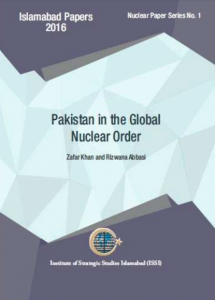-Zafar Khan and Rizwana Abbasi, Pakistan

Pakistan‘s nuclear policy and doctrinal strategic posture revolve around the broader contours of minimum deterrence as discussed above. In a similar context, Pakistan officially declares and practices credible minimum deterrence. The concept of minimum was espoused by Pakistan even before the nuclear tests in 1998. Pakistan‘s former Chief of Army Staff, General Aslam Beg, for instance, stated in an interview in September 1992 that ―In the case of weapons of mass destruction it is not the number that matters, but the destruction that can be caused by even a few…The fear of retaliation lessens the likelihood of full-fledged war between India and Pakistan. The logic is: if few could deter why go for more.
Pakistan decided to adopt a credible minimum deterrence policy for various reasons: 1) Pakistani security establishment was convinced that minimum would deter, as few had sufficed in the past to stave off an Indian attack; 2) it deflected the international community‘s direct pressure as part of the general non-proliferation efforts, though Pakistan was not a party to the NPT nor had it intended to join it; 3) the minimum eases the pressure on strategic command and control with regard to both development and employment. With more, there would be a greater pressure on command and control. More importantly, for Pakistan minimum can be better protected and secured. The minimum can also be better concealed and dispersed as part of nuclear strategy, which in turn enhances the credibility of deterrence. The minimum is, thus, better, safer and more prudent; 4) In Pakistani context, the minimum has the advantage of being cost-effective. Although Pakistan‘s economy is growing gradually, a bigger number would still require an even bigger economy and a stronger industrial base. The minimum, apart from being an effective deterrent, is affordable for a developing country like Pakistan.
Empirical evidence suggests that Pakistan has successfully deterred India with its minimum deterrence capability. The policy statements of Pakistani leaders, however, indicate that minimum is not a static capability; it is flexible; and it would evolve in accordance with the changing strategic environment.
For example, Sattar et al stated: ―Minimum is open for debate. It has got an open interpretation. It remains flexible. There is no number game. It, thus, remains a non-fixed entity.‖14They added:
―Minimum nuclear deterrence will remain the guiding principle of our nuclear strategy. The minimum cannot be quantified in
Static numbers.
 Abdul Sattar, the former Foreign Minister of Pakistan during the early period of President Musharraf regime, told the first author of this report that ―the minimum what we had in 2000 may not be similar in the year we are. It has to gradually change in accordance with the changed strategic circumstances. This reflects the centrality of ambiguity around minimum deterrence in South Asia. In fact, ambiguity has become the central part of both Pakistan and India‘s nuclear thinking. However, the level of ambiguity varies from one nuclear weapons state to another for strategic reasons. Pakistan‘s security establishment, for example, considers ambiguity a hallmark of minimum deterrence. They consider that ambiguity has served the purpose of deterrence. It keeps the adversary guessing as to how the other side may strategize. Simply put: if ambiguity serves the purpose, why go open. We argue that ambiguity is one of the essentials of Pakistan‘s credible minimum deterrence. Nuclear weapons states believe that too much openness and transparency in nuclear policy erode the credibility of deterrence.
Abdul Sattar, the former Foreign Minister of Pakistan during the early period of President Musharraf regime, told the first author of this report that ―the minimum what we had in 2000 may not be similar in the year we are. It has to gradually change in accordance with the changed strategic circumstances. This reflects the centrality of ambiguity around minimum deterrence in South Asia. In fact, ambiguity has become the central part of both Pakistan and India‘s nuclear thinking. However, the level of ambiguity varies from one nuclear weapons state to another for strategic reasons. Pakistan‘s security establishment, for example, considers ambiguity a hallmark of minimum deterrence. They consider that ambiguity has served the purpose of deterrence. It keeps the adversary guessing as to how the other side may strategize. Simply put: if ambiguity serves the purpose, why go open. We argue that ambiguity is one of the essentials of Pakistan‘s credible minimum deterrence. Nuclear weapons states believe that too much openness and transparency in nuclear policy erode the credibility of deterrence.
A Carnegie-Stimson report on Pakistan claims that Pakistan is expanding production of its nuclear weapons, delivery vehicles and fissile material to an alarming scale. The authors of the report estimate that Pakistan has the ―potential to produce 20 nuclear warheads yearly whereas India appears to be producing five warheads annually. The report speculates that ―in the next 5 to 10 years Pakistan could have a nuclear arsenal not only twice the size of India‘s but also larger than those of the United Kingdom, China, and France, giving it the third-largest arsenal behind the United States and Russia.
Kristensen and Norris have produced another parallel account that makes the Carnegie-Stimson report‘s estimates about Pakistan‘s nuclear power look exaggerated. Kristensen and Norris believe that, ―Pakistan simply does not have the industrial capacity to develop, produce and deploy that many additional nuclear weapons systems in a decade. They add: ―Calculations must take into account that not all of a country‘s fissile material ends up in warheads. For them: ―Pakistan lacks enough nuclear capable delivery vehicles to accommodate 200-300 warheads. In addition, all of Pakistan‘s nuclear capable delivery systems are dual-capable, which means some of them are presumably assigned non-nuclear mission.
 As per International Panel on Fissile Materials (IPFM), India has overtaken Pakistan and enjoys a huge advantage in fissionable material stocks, which means India has achieved the capability to produce more warheads than Pakistan could ever produce. Also, the IPFM has dubbed the Carnegie-Stimson report projecting Pakistan‘s capability of producing more warheads than India in the next ten years as exaggerated.
As per International Panel on Fissile Materials (IPFM), India has overtaken Pakistan and enjoys a huge advantage in fissionable material stocks, which means India has achieved the capability to produce more warheads than Pakistan could ever produce. Also, the IPFM has dubbed the Carnegie-Stimson report projecting Pakistan‘s capability of producing more warheads than India in the next ten years as exaggerated.
There is something seriously amiss with the Carnegie-Stimson ―estimates‖ as they do not pick the correct Indian samples and do not factor in the fuel from eight unsafeguarded reactors on the assumption that it would be utilized in India‘s upcoming fast breeder reactors. That is a huge and simplistic assumption, which erroneously disregards tons of weapons-grade plutonium that India has accumulated over the years. Some recent revelations indicate that the Indo-US nuclear deal ―also allowed [ten] other reactor sites subject to the IAEA inspection to use imported uranium fuel, freeing up an indigenously mined supply of uranium that was not tracked by the international community -and could now be redirected to the country‘s bomb programme.
Seen simplistically, how could have India remained in its comfort zone, developed a number of delivery systems in its inventory and a full triad of nuclear forces if it were to remain at the stock levels that the Western authors have been projecting for over a decade. Conversely, Pakistan has a modest missile programme of eight land-based systems. Its fissile material requirements, too, have remained meagre.
Pakistan‘s official stance remains unchanged as it continues to follow credible minimum deterrence. If Pakistan strictly follows the basic ingredients of deterrence and does not expand to the level of the classic Cold War arms race, then its policy posture remains consistent with the basic essentials of credible minimum deterrence. Pakistan has not built deterrence forces on a massive scale, nor does it plan to do so. Pakistan may not need to follow major nuclear weapons states or India for an open-ended arms race. Pakistan‘s deterrence forces are India-centric. Therefore, the ―minimum remains the most feasible and desirable option to deter Indian aggression as reiterated from time to time by Pakistan‘s National Command Authority (NCA). Pakistan is confident that its policy of credible minimum deterrence has worked and thwarted India in the past and that it would work in future. Its predilection for full spectrum deterrence is not about numbers; it is about deterring India from initiating any type of war that plugs all the gaps in deterrence.
Full Spectrum Deterrence:
Like the minimum deterrence, the concept of full spectrum deterrence emerged during the peak of the Cold War when both the US and the Soviet Union were building deterrence forces for both offensive and defensive purposes in order to plug the gaps within their deterrence capabilities, which included full spectrum of targeting through a Single Integrated Operational Plan (SIOP). Neither of them opted for minimum deterrence.
Evidently, Pakistan‘s articulation of full spectrum deterrence subsumes credible minimum deterrence, and it is conceived in a strategic environment different from the Cold War period. Interestingly, the Carnegie-Stimson report attempts to place Pakistan within the Cold War strategic environment and assumes that Pakistan is competing against India in terms of acquiring various types of deterrence forces along with their delivery systems, whilst completely overlooking India‘s rapid and ambitious nuclear expansion. The report does not capture the prevailing strategic environment of South Asia where one country‘s deterrence capability affects the other. Pakistan cannot be analyzed in isolation without India. The report does not specifically define what full spectrum deterrence would be in South Asia, nor covers ground on how and why Pakistan is being, willy-nilly, pulled into an arms race. Also, the report fails to distinguish between the full spectrum deterrence and strategic deterrence. We link strategic deterrence to bigger nuclear weapons particularly designed to hit the cities as part of the counter-value targeting strategy, whilst full spectrum deterrence is a supplement to the strategic deterrence, but it embodies miniaturized/smaller nuclear weapons used for counter-force targeting. In the Pakistani context, it would mean to plug the gaps in strategic deterrence in response to India‘s conventional and nuclear strategies. However, in effect, both strategic and full spectrum deterrence are intertwined and, thus, remain consistent with the broader contours of Pakistan‘s credible minimum deterrence.
Hence, the Carnegie-Stimson report‘s frame of reference needs to move away from the Cold War‘s full spectrum deterrence which, strictly speaking, is not relevant to Pakistan‘s credible minimum deterrence, as it aims at deterring all forms of aggression. Pakistan‘s NCA has recently stated that, ―Pakistan would not remain oblivious to evolving security dynamics in South Asia and would maintain a full spectrum deterrence capability to deter all forms of aggression.
In the same context, a Pakistan‘s Inter-Services Public Relations (ISPR) statement elaborated that, ―in view of the growing conventional asymmetry, the NCA reiterated the nation‘s resolve to maintain full spectrum deterrence capability in line with the dictates of credible minimum deterrence to deter all forms of aggression, adhering to the policy of avoiding an arms race.‖26 Conceptually, full spectrum deterrence capability falls within the broader parameters of the minimum deterrence; has nothing necessarily to do with increasing number of deterrent forces this stays as one of the essential pillars of Pakistan‘s nuclear policy; eases the unexpected pressure on command and control system; reinforces nuclear stability; strengthens the credibility of minimum deterrence; avoids the erosion of deterrence stability in South Asia; addresses the issues of increasing conventional asymmetry; remains defensive; bridges the gaps within deterrence; and aims to deter all forms of aggression at the strategic and conventional levels.
In response to India‘s military CSD, whereby India has been preparing to fight a limited war to achieve its political and military objectives under the nuclear overhang, Pakistan was compelled to include low-yield nuclear weapons into its inventory. How would a ―normal‖ nuclear weapons state respond to such an aggressive posture when its conventional asymmetry viz-a-viz its nuclear adversary widens exponentially? Pakistan‘s development of Nasr is not meant to wage a limited war against India, but to prepare for such an eventuality signaling to the adversary strong and punitive retaliation and reducing the probability of any kind of aggression or limited war.
The predicaments of ―use it or lose it‖ with regard to the tactical nuclear weapons (TNWs), pre-delegation, and the issue of command and control, all influenced by the bigger geographical distances between the US and the Soviet Union, largely existed during the Cold War period. Pakistan‘s centralized command and control and shorter distances between India and Pakistan immediately rule out these risks.28 If a ―normal‖ nuclear Pakistan considers low-yield battlefield weapons as meant to deter a CSD-driven limited war offensive, then it is essentially an instrument to avert aggression. The political considerations with regard to Nasr development remain consistent with Pakistan‘s credible minimum deterrence posture. Therefore, the CSD appears to be offensive whilst Nasr is a defensive system designed to uphold deterrence and strategic stability in South Asia and prevent a major war.
It would be extremely pessimistic, as the Carnegie-Stimson report suggests, that Pakistan would need to find an alternative nuclear future to become a ―normal nuclear weapons state, keep ―strategic deterrence based upon the principles of ―assured destruction and stop developing short range delivery vehicles in response to a limited war that could be imposed on Pakistan by India‘s proactive military doctrine. In other words, Pakistan would need to keep strategic weapons for the worst-case scenario and cap the short and longer-range deterrence capabilities against the adversary. This proposed alternative nuclear future does not fully serve Pakistan‘s security and national interests. Some reasons are highlighted below.
First, such a policy would undercut the credibility of its minimum deterrence if Pakistan did not develop a short-range deterrence capability to counter the CSD that aims at waging a limited war against Pakistan from eight integrated points31 under the nuclear overhang.
Second, plugging no gaps against the possibility of CSD operations for a ―limited conventional war, as the report suggests, would allow India to exploit Pakistan‘s vulnerabilities and deterrence weaknesses. This is not merely theoretical because India in pursuance of the CSD did contemplate a surgical strike against Pakistan in the aftermath of the Mumbai terrorist attacks in 2008. Conceptually, the development of Nasr as a low-yield battlefield weapon demonstrates what Lawrence Freedman once stated ―I exist; therefore, I deter. Nasr can, therefore, be seen as an instrument for nuclear peace in South Asian deterrence stability disrupted by India‘s Pragati/Prahaar short range nuclear capability. Therefore, the development of Nasr, specific to India‘s development of battlefield nuclear weapons and CSD, becomes part of Pakistan‘s deterrence capability without which its deterrence credibility could be extremely weakened.
Third, strategic deterrence, as defined by the Carnegie Stimson report in the worst-case scenario resulting in nuclear exchanges and major conventional warfare, cannot be a rational response to deter a limited war emanating from the CSD. If this was the case, both the Soviet Union and the US would not have crafted a strategy for building and deploying the TNWs to deter a limited war. Although neither the US nor the Soviet Union had used the TNWs, they still exist both in Europe and Russia, successor to the Soviet Union, for deterrence purposes. In fact, despite the end of the Cold War, TNWs still play a role in the United States‘extended deterrence in Europe.
Finally, Nasr’s development falls within the broader contours of Pakistan‘s declarations on credible minimum deterrence and full spectrum deterrence. It does not imply numerical expansion in deterrence forces. The increase within Pakistan‘s deterrence capability would be in proportion to India‘s planned expansion. This may, however, not exactly be within the parameters of weapon-to-weapon competitive strategy practiced during the Cold War. Whether Pakistan would practice recessed deterrence or follow the ready-arsenal strategy for some of its deterrence forces would depend on the prevailing strategic environment.
# Thanks text courtesy: Pakistan in the Global Nuclear Order, Islamabad Papers 2016, nuclear paper series No. 1: Ed. Upadhyaya.
